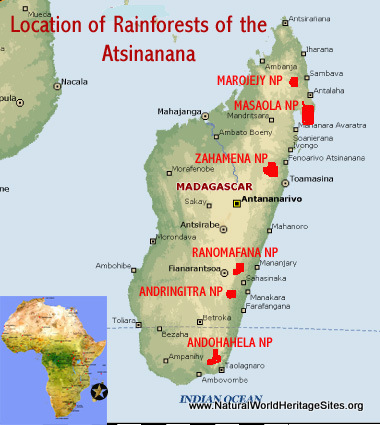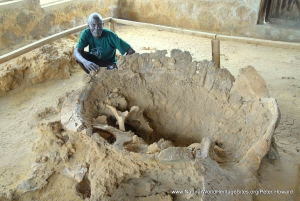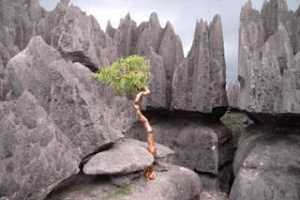EXPLORE MADAGASCAR’S RAINFORESTS OF THE ATSINANANA with this slideshow, check the location map and get all the facts and information below.
For slideshow description see right or scroll down (mobile). Click to view slideshow
Values: The six national parks which make up this serial site (namely Marojejy, Masaola, Zahamena, Ranomafana, Andringitra and Andohahela) are located along the 1,600 kilometre length of eastern Madagascar and represent the remnants of rainforests that used to cover much of the eastern half of the country. They are critically important for maintaining the ecological processes which have resulted in Madagascar’s unique biodiversity. Ninety seven percent of the species found in these moist forests occur only in Madagascar, and the site protects two-thirds of the island’s mammals, including 25 species of lemur.
REVIEW OF WORLD HERITAGE VALUES: According to IUCN’s Conservation Outlook Assessment (2014), the specific attributes which qualify the Rainforests of the Atsinanana for world heritage status can be summarised as follows:
Diversity of habitats. The altitudinal range (0-2658 m) covered by the six protected areas that make up the world heritage site spans an exceptional diversity of Madagascar’s humid habitats. These include coastal and lowland rainforest in Masoala; mid-level and montane rainforest at all sites; lower dry montane forest at Marojejy, Andringitra and Andohahela; ericoid montane thicket above 1800 m at Andohahela; and swamp vegetation at Ranomafana.
Rare and endemic birds. 173 bird species occur within the site, representing 61% of all species recorded in Madagascar. These include members of five endemic or near-endemic families (Brachypteraciidae, Mesitornithidae, Bernieridae, Vangidae and Leptosomatidae) and two endemic subfamilies (Couinae and Philepittinae). Eighteen species are recognised on the IUCN Red List of Threatened Species, including the endangered Madagascar serpent eagle (Eutriorchis astur) and the endangered Madagascar red owl (Tyto soumagnei).
Rare and threatened mammals. Of the 123 species of non-flying mammals in Madagascar, 78 occur within the site. All of them are endemic (i.e. not found outside Madagascar) and 72 are included on the IUCN Red List of Threatened Species. All five families of lemur are represented, as well as six genera of carnivores (civets and mongooses), seven genera of rodents and six genera of tenrecs.
Endemic reptiles and amphibians. At least 160 species of amphibian and 164 species of reptiles have been recorded within the six protected areas that make up the world heritage site. The vast majority of these are found only in Madagascar (99% of amphibians occur nowhere else in the world, while 92% of reptiles are endemic). There are likely to be many more species to be recorded as more research is carried out and new discoveries are made (for example, 31 undescribed species of amphibian are known from Ranomafana, awaiting scientific recognition).
Rich endemic flora. At least 11,220 species of vascular plant occur in Madagascar, of which 84% occur nowhere else in the world (i.e. are endemic). The Rainforests of the Atsinanana are known to harbour at least 2,984 of these species including members of at least 97 of the country’s 209 endemic plant genera and five of its six endemic families.
Ongoing ecological processes necessary for the survival of Madagascar’s unique biodiversity. The Rainforests of the Atsinanana are relict forests, lying on steeper terrain along the eastern escarpment and mountains of Madagascar. Each of the protected areas has unique qualities and collectively they conserve a range of ecological interactions and processes necessary for the survival of Madagascar’s unique rainforest biodiversity. They have provided important refuge for species during past periods of climate change and will be essential for the adaptation and survival of species in future.
CONSERVATION STATUS AND PROSPECTS: The rugged nature of the terrain and poor access to most of the protected areas affords them a high degree of inherent protection, so threats tend to be localised and relatively low level. Nevertheless, there are large numbers of people living in close proximity to many of the rainforests who depend on forest resources and often exploit them illegally and unsustainably. Illegal logging became a major issue in 2009, prior to the site’s inclusion on the official list of World Heritage Sites In Danger, but this threat has subsequently been brought under some degree of control. Illegal agricultural encroachment occurs within each of the protected areas, as well as illegal hunting and small-scale artisanal mining. Appropriate management systems are in place but the management agency responsible is under-resourced and the political will to enforce protection measures is sometimes lacking.
MANAGEMENT EFFECTIVENESS: The site is on the List of World Heritage Sites In Danger because the Madagascar authorities have been unable to address ongoing threats. In particular, many of the protected areas are suffering from illegal logging, while agricultural encroachment and artisanal mining also occur in certain localities within the reserves. In general, appropriate legislation, management plans and procedures are in place, but their implementation is weak and ineffective. Part of the problem seems to be a lack of political will to tackle the issues.
REVIEW OF CONSERVATION ISSUES AND THREATS: The following issues represent specific threats to the ecology, conservation and values of the Rainforests of the Atsinanana world heritage site.
Illegal Logging. This is a major threat to all six protected areas, which reached crisis proportions during Madagascar’s political upheavals of 2009. At that time, very large numbers of high-value hardwoods (rosewood and ebony) were exploited from Marojejy and Masoala reserves, destined for the export market. More than 60,000 trees were harvested, impacting at least 4,000 ha within these two reserves, where a further 500,000 additional trees were cut to facilitate transport. Fortunately, following international intervention and Danger listing of the world heritage site the illegal logging was brought under control and by 2011 commercial logging had been stopped in Marojejy and much reduced in Masoala. In all six reserves, however, timber continues to be exploited to satisfy local and regional demand. Logging degrades natural habitats and has knock-on effects for many aspects of forest ecology, increasing the risk of fire, allowing the establishment of invasive species, and reducing biodiversity. It may also facilitate access and lead to increased levels of hunting, illegal settlement and mining.
Agricultural encroachment. Slash-and-burn cultivation is considered the primary threat to Madagascar’s forests, resulting in increased isolation of protected areas as ‘habitat islands’ in a deforested landscape. Cultivation is becoming increasingly intense around the fringes of all six components of the world heritage site, and in some cases extending into the reserves themselves, particularly along river valleys.
Livestock Grazing. This is known to affect at least three of the protected areas – Zahamena, Andringitra and Andohahela – and probably occurs elsewhere in the world heritage site. Its impact on rainforest ecology and conservation is unknown, but it may limit regeneration of some rainforest trees.
Artisanal mining and quarrying. Mining activities, which commonly involve large numbers of people using basic hand tools to dig, refine and extract minerals, have been recorded in Ranomafana, Zahamena, Marojejy and Masaola. The impact of these activities is generally quite localised, although mining may draw immigrants into a previously pristine area where settlement, hunting and exploitation of other forest resources often follows.
Hunting. Lemurs, birds and small mammals are hunted by members of forest-adjacent communities for local consumption in all six areas. This may be sustainable in some cases but becomes a major threat when it is associated with an influx of people carrying out activities such as illegal logging or mining. During the recent (2009) logging crisis in Masoala scientists from the New York-based Wildlife Conservation Society (WCS) recorded a massive increase in trapping of lemurs for the commercial bushmeat trade, and a corresponding 30-75% reduction in lemur population densities. As lemurs are ‘keystone’ species responsible for seed dispersal and other ecological services commercial hunting of this nature poses a serious threat to the wider ecology of the forests.
Changing local community dynamics and traditions. Local resident communities often hold traditional beliefs and local taboos (known as ‘fady’) that have served to protect particular forest species such as lemurs in some areas. Such traditional belief systems and the conservation benefits they bring can be disrupted by an influx of people attracted by illegal logging and artisanal mining opportunities.
Fire. Intact rainforests do not burn, but fires used for pasture renewal outside forests may progressively push back the forest margins. This is considered to be a threat to five of the six areas included in the world heritage site.
Invasive Alien Species. The occurrence and possible impact of invasive plant and animal species in the Rainforests of the Atsinanana has not been evaluated, but based on experience elsewhere it is an issue that requires attention. Invasive species often displace indigenous plants and animals, reducing ecosystem function and biodiversity.
Climate change. All six protected areas are associated with mountain systems, so global warming is likely to result in upslope displacement of habitats and species over time. Such displacements have already been observed at Tsaratanana, a site adjacent to Marojejy reserve.
Inappropriate tourism development. Visitor pressures on the world heritage site are currently very low, but are likely to increase in future and require management intervention. Some hotel developments on the west coast of the Masaola peninsula seem to have proceeded without adequate environmental impact assessment.
Roads, railways and infrastructure development. There are few roads, transport corridors or other strategic infrastructure in most of the protected areas at present, but a tarmac road passes through the core of Ranomafana reserve. Any further such developments should be avoided (or at least involve very careful planning) to minimise potentially damaging consequences and ensure appropriate environmental safeguards.
Use of non-timber forest products. Non-timber forest products such as medicinal plants, fruit, honey, fish, wild silk, fibres for construction etc. are widely collected by local communities throughout the country. This has been identified as a threat to five of the protected areas but little is known about its impacts on particular target species.
Links:
Google Earth
UNEP-WCMC Site Description
IUCN Conservation Outlook
UNESCO Offical Website
Birdlife IBA
Slideshow description
The Slideshow provides a comprehensive overview of Madagascar’s Rainforests of the Atsinanana (World Heritage Site In Danger), showing the area’s tropical forest landscapes, wildlife habitats, endemic plants and animals, lemurs, chameleons and other threatened species, conservation management issues, local community livelihoods and some of the visitor facilities and typical experiences.
Factfile
Website category: Islands
Area (serial site): 4,796 km2
Inscribed: 2007
Criteria:
- (ix) ecological processes;
- (x) biodiversity





